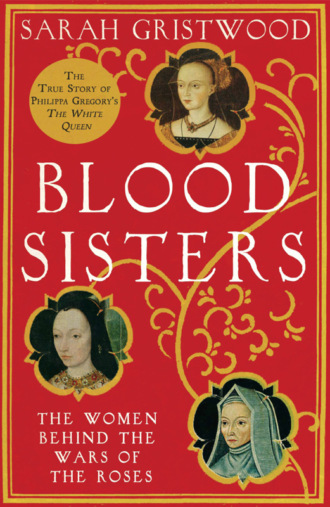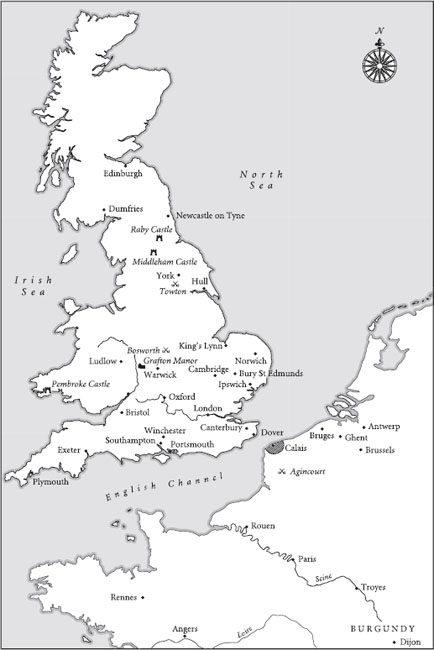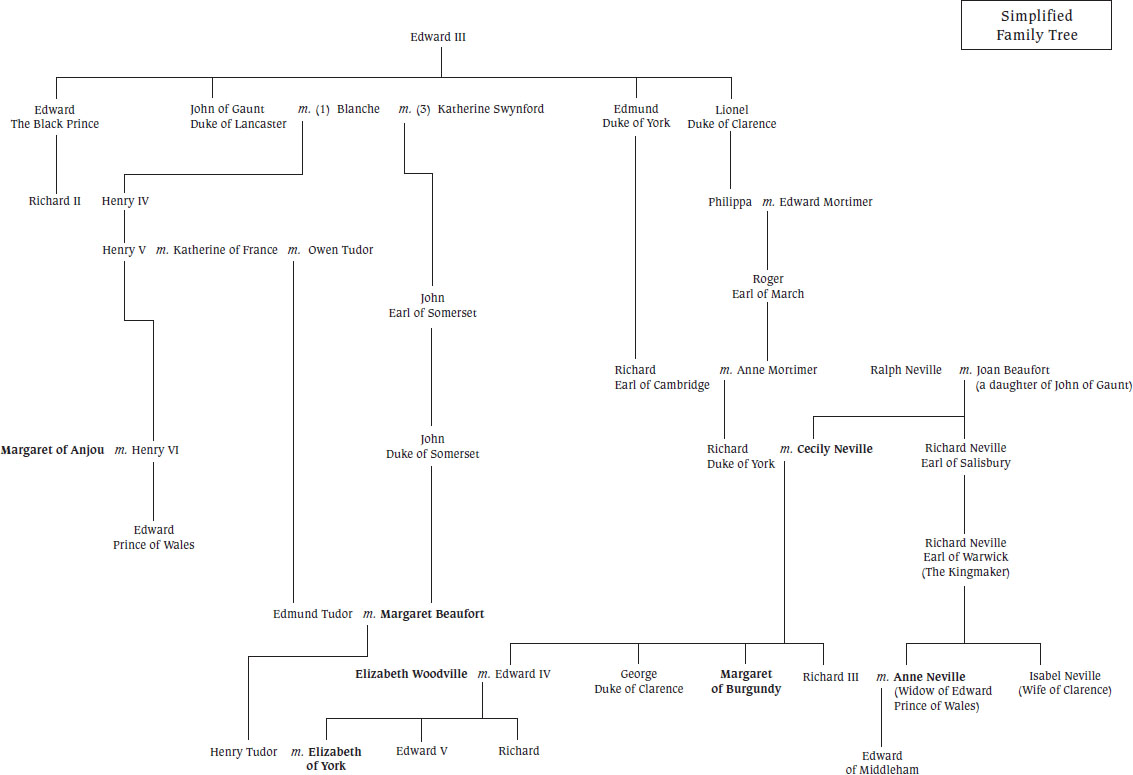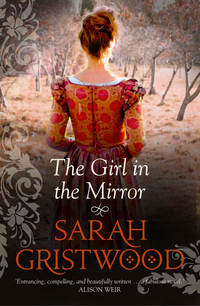
Полная версия
Blood Sisters: The Hidden Lives of the Women Behind the Wars of the Roses

SARAH GRISTWOOD
Blood Sisters
The Hidden Lives of the Women
Behind the Wars of the Roses


William Collins
An imprint of HarperCollinsPublishers Ltd.
1 London Bridge Street
London SE1 9GF
www.harpercollins.co.uk
Published by HarperPress in 2012
Copyright © Sarah Gristwood 2012
Sarah Gristwood asserts the moral right to be identified as the author of this work
A catalogue record for this book is available from the British Library
All rights reserved under International and Pan-American Copyright Conventions. By payment of the required fees, you have been granted the non-exclusive, non-transferable right to access and read the text of this ebook on-screen. No part of this text may be reproduced, transmitted, down-loaded, decompiled, reverse engineered, or stored in or introduced into any information storage and retrieval system, in any form or by any means, whether electronic or mechanical, now known or hereinafter invented, without the express written permission of HarperCollins ebooks
HarperCollinsPublishers has made every reasonable effort to ensure that any picture content and written content in this ebook has been included or removed from this ebook in accordance with the contractual and technological constraints in operation at the time of publication
Source ISBN: 9780007309306
Ebook Edition © 2013 ISBN: 9780007309320
Version: 2017-03-29
CONTENTS
Title Page
Copyright
List of Illustrations
Map
Simplified Family Tree
Glossary of Names
Reigns
Prologue
PART ONE: 1445–1461
1. Fatal Marriage
2. The Red Rose and the White
3. A Woman’s Fear
4. No Women’s Matters
5. Captain Margaret
6. Mightiness Meets Misery
PART TWO: 1461–1471
7. To Love a King
8. Fortune’s Pageant
9. Domestic Broils
10. That Was a Queen
PART THREE: 1471–1483
11. My Lovely Queen
12. Fortune’s Womb
13. Mother of Griefs
14. A Golden Sorrow
PART FOUR: 1483–1485
15. Weeping Queens
16. Innocent Blood
17. Letters to Richmond
18. Anne My Wife
19. In Bosworth Field
PART FIVE: 1485–1509
20. True Succeeders
21. Golden Sovereignty
22. The Edge of Traitors
23. Civil Wounds
24. Like a Queen Inter Me
25. Our Noble Mother
Epilogue
Keep Reading
Footnotes
Notes
Picture Section
Select Bibliography
Index
Acknowledgements
About the Publisher
LIST OF ILLUSTRATIONS
1. Marguerite of Anjou with Henry VI and John Talbot in the ‘Shrewsbury Talbot Book of Romances’, c.1445. British Library, Royal 15 E. VI, f.2v (© The British Library Board)
2. The stained-glass Royal Window in Canterbury Cathedral (© Crown Copyright. English Heritage)
3. Margaret Beaufort by Rowland Lockey, late 16th century (By permission of the Master and Fellows of St John’s College, Cambridge)
4. Margaret Beaufort’s emblems (© Neil Holmes/The Bridgeman Art Library)
5. Cecily Neville’s father, the Earl of Westmoreland, with the children of his second marriage (Bibliothèque Nationale, Paris/Flammarion/The Bridgeman Art Library)
6. Portrait of Elizabeth Woodville from 1463 (© The Print Collector/Corbis)
7. Anne Neville depicted in the Rous Roll, 1483–85. British Library Add 48976 (© The British Library Board)
8. King Richard III by unknown artist, oil on panel, late 16th century; after unknown artist late 15th century (© National Portrait Gallery, London)
9. The risen Christ appearing to Margaret of Burgundy by the Master of Girard de Rousillon, from Le dyalogue de la ducesse de bourgogne a Ihesu Crist by Nicolas Finet, c.1470. British Library Add.7970, f.1v (© The British Library Board)
10. Elizabeth of York by unknown artist, oil on panel, late 16th century; after unknown artist c. 1500 (© National Portrait Gallery, London)
11. The birth of Caesar from Le fait des Romains, Bruges, 1479. British Library Royal 17 F.ii, f.9 (© The British Library Board)
12. The Devonshire Hunting Tapestry – Southern Netherlands (possibly Arras), 1430–40 (© Victoria and Albert Museum, London)
13. Procession at the Funeral of Queen Elizabeth, 1502 (© The Trustees of the British Museum)
14. The preparations for a tournament. Illustration for René of Anjou’s Livre des Tournois, 1488–89? Bibliothèque nationale de France, Francais 2692, f.62v–f.63 (Bibliothèque nationale de France)
15. Margaret of Burgundy’s crown, Aachen Cathedral Treasury (© Domkapitel Aachen (photo: Pit Siebigs))
16. Song ‘Zentil madona’: from Chansonnier de Jean de Montchenu, 1475?, Bibliothèque nationale de France, MS Rothschild 2973, f.3v–f.4 (Bibliothèque nationale de France)
17. The Tower of London from the Poems of Charles of Orleans, c.1500. British Library, Royal 16 F. II f.73 (© The British Library Board)
18. Elizabeth of York’s signature on a page of ‘The Hours of Elizabeth the Queen’, c.1415–20. British Library Add 50001, f.22 (© The British Library Board)
19. Wheel of Fortune illumination from the Troy Book, c.1455–1462. British Library Royal 18 D.II, f.30v (© The British Library Board)
MAP

SIMPLIFIED FAMILY TREE

GLOSSARY OF NAMES
ANNE: the name borne by Anne Neville (1456–85); daughter to the Earl of Warwick, wife first to Edward of Lancaster and then to Richard III. Her mother was another Anne, the heiress Anne Beauchamp, Countess of Warwick (1426–90). Anne was also the name given to the Duchess of Exeter (1439–76), eldest daughter of Richard, Duke of York and Cecily Neville and sister to Edward IV and Richard III. Other English noblewomen bearing the name include one of Cecily’s sisters, who became Duchess of Buckingham; one of Edward IV’s daughters; and Anne Mowbray who was married in childhood to Edward’s youngest son.
BEAUFORT: the family name of Margaret Beaufort (1443–1509), mother to Henry VII, and of the Dukes of Somerset, one of whom was Margaret’s father. The Beaufort family also included Cardinal Beaufort, advisor to Henry VI.
BUTLER, ELEANOR (?–1468): born Eleanor Talbot; the woman who was later said to have been secretly married to Edward IV.
CECILY NEVILLE (or Cicely, 1415–95): matriarch of the York dynasty; wife to Richard, Duke of York; mother to Edward IV and Richard III. The name was also shared by Cecily’s granddaughter (Edward IV’s daughter, 1469–1507).
CLARENCE, GEORGE, DUKE OF (1449–78): son to Cecily Neville and Richard Duke of York. The second of their sons to survive into maturity, Clarence was famously executed on the orders of his brother Edward IV.
DORSET, MARQUIS OF (1455–1501): the title bestowed on Thomas Grey, the eldest son of Elizabeth Woodville by her first husband, John Grey.
EDMUND, EARL OF RUTLAND (1443–60): second son to Richard, Duke of York and Cecily Neville, killed young in battle.
EDWARD: this name was borne most importantly by Edward IV (1442–83), eldest son to Richard, Duke of York and Cecily Neville; and by his own eldest son (1470–83?), the elder of the ‘Princes in the Tower’, who would have reigned as Edward V. The name Edward was also bestowed, however, on the eldest sons both of Henry VI (‘Edward of Lancaster’, 1453–71) and of Richard III (‘Edward of Middleham’, 1476?–84). Both were, in their time, also Prince of Wales. The name Edward may have been considered particularly suitable for kings or prospective kings, perhaps because the last undisputed king of England had been the mighty Edward III. Henry VIII, in the next century, would also call his son ‘Edward’.
ELIZABETH: the name borne by Elizabeth Woodville (1437–92), queen to Edward IV, and by their daughter Elizabeth of York (1466–1503), who would marry Henry VII. It was also the name borne by Edward IV’s sister (1444–1503), who became Duchess of Suffolk.
GEORGE: see Clarence, above.
GLOUCESTER, RICHARD, DUKE OF: the title borne in early adulthood by the future Richard III.
HENRY: the name borne by successive Lancastrian and later Tudor kings; Henry V (1387–1422), Henry VI (1421–71), Henry VII (‘Henry Tudor’, 1457–1509) and Henry VIII (1491–1547).
ISABEL NEVILLE (1451–76): daughter to the Earl of Warwick and elder sister to Anne Neville, wife to George, Duke of Clarence.
JACQUETTA WOODVILLE (1415?–72): born Jacquetta of Luxembourg, mother of Elizabeth Woodville, wife to Sir Richard Woodville, subsequently created Earl Rivers. She had previously, by her first marriage, been Duchess of Bedford.
KATHERINE: the name borne by one of Edward IV’s daughters, and also given to Katherine Gordon, wife to the pretender Perkin Warbeck. Also Katherine (or Catherine) of Aragon (1485–1536): daughter of the Spanish monarchs Ferdinand of Aragon and Isabella of Castile, she was brought to England to marry Arthur, son to Henry VII and Elizabeth of York. She subsequently became the first wife of Arthur’s brother Henry VIII.
LANCASTER: the name of one of the two great rival houses, the other being York, sometimes identified by the symbol of the red rose.
MARGARET: besides Margaret Beaufort, the name was borne by Margaret (or Marguerite) of Anjou (1430–82), queen to Henry VI and mother to Edward of Lancaster. Margaret (Margaret ‘of Burgundy’ or ‘of York’, 1446–1503) was also the name of the youngest daughter of Cecily Neville and Richard, Duke of York, sister to Edward IV and Richard III, who was married to Charles, Duke of Burgundy. Yet another Margaret was Margaret Tudor (1489–1541), eldest daughter of Elizabeth of York and Henry VII, who was married to the king of Scots.
MARY: the younger daughter of Henry VII and Elizabeth of York was Mary Tudor (1495/6–1533), who would be married to the king of France. The name also belonged to Mary of York (1467–82), one of Elizabeth of York’s sisters, as well as to Mary of Burgundy.
NEVILLE: name of the great northern family to which Cecily and Anne both belonged, Anne’s father Warwick being the son of Cecily’s brother, Salisbury. The Neville family was a particularly extensive one, not all of whose members would necessarily be on the same side.
PASTON: name of the Norfolk gentry family whose letters, down the generations, provide an invaluable background to this period.
RICHARD: name borne by Richard, Duke of York (1411–60); by his youngest son Richard III (1452–85); and by the younger of the two ‘Princes in the Tower’ (1473–83?).
SOMERSET, DUKES OF: John Beaufort, Earl (later first Duke) of Somerset (1404–44) was Margaret Beaufort’s father. He was succeeded by his brother Edmund Beaufort, second Duke of Somerset (1405–55), who in turn was succeeded by his son Henry, the third duke (1436–64). When Henry was executed his younger brother, another Edmund (1439–71), assumed the title of fourth duke, although it was never formally granted to him.
STAFFORD, SIR HENRY (1425?–71): second husband of Margaret Beaufort, a son to the Duke of Buckingham.
STANLEY, THOMAS, LORD STANLEY, EARL OF DERBY (1435?–1504): third husband of Margaret Beaufort and a powerful magnate.
SUFFOLK, WILLIAM DE LA POLE, DUKE OF (1396–1450): favourite minister of Henry VI and Marguerite of Anjou. He was married to Alice Chaucer (1404–75), a granddaughter of the poet Chaucer. William was succeeded by his son John (1442–91) who, despite the family’s Lancastrian affiliations, was married to Elizabeth, sister to Edward IV and Richard III, daughter of Richard, Duke of York and Cecily Neville.
TUDOR: the family name of Henry VII, of his father Edmund (1428–56) and his uncle Jasper (1431–95). The Welsh Tudors were a comparatively obscure family until Edmund’s father Owen (1400–61) became the second husband of Henry V’s widow.
WARWICK, RICHARD NEVILLE, EARL OF (1428–71): known as the ‘Kingmaker’ for the prominent role he played in placing the house of York on what had previously been a Lancastrian throne. He was the father of Isabel and Anne Neville, both of whom he married to York brothers.
WOODVILLE (or Wydeville): the birth family of Elizabeth Woodville, Edward IV’s queen. Notable among her numerous siblings was her eldest brother Anthony (1440?–83), who became Earl Rivers on his father’s death.
YORK: (as in Richard, Duke of, above). The second of the two great warring families, often identified by the symbol of a white rose.
Of the seven women whose stories I explore, the fashions of the times mean that two are called Elizabeth and three, Margaret. I have therefore referred to the York princess who married the Burgundian ruler as Margaret ‘of Burgundy’, while giving Margaret of Anjou the French appellation she herself continued sometimes to use after marriage – Marguerite. The family originally spelt as ‘Wydeville’ has been given its more familiar appellation of ‘Woodville’, and other spellings and forms have sometimes been modernised. The quotations at the top of each chapter have been drawn from Shakespeare’s history plays.
PROLOGUE
February 1503
She had died on her thirty-seventh birthday and that figure would be reiterated through the ceremony. Thirty-seven virgins dressed in white linen, and wreathed in the Tudor colours of green and white, were stationed in Cheapside holding burning tapers; thirty-seven palls of rich cloth were draped beside the corpse. The king’s orders specified that two hundred poor people in the vast and solemn procession from the Tower of London to Westminster should each carry a ‘weighty torch’, the flames flickering wanly in the February day.1
For Elizabeth of York had been one of London’s own. Her mother Elizabeth Woodville had been the first English-born queen consort for more than three centuries, but where Elizabeth Woodville had been in some ways a figure of scandal, her daughter was less controversial. She had been a domestic queen, who gave money in return for presents of apples and woodcocks; and bought silk ribbons for her girdles, while thriftily she had repairs made to a velvet gown. Elizabeth rewarded her son’s schoolmaster, bought household hardware for her newly married daughter, and tried to keep an eye out for her sisters and their families. The trappings of the hearse showed she was a queen who had died in childbirth, a fate feared by almost every woman in the fifteenth century.
She had been, too, a significant queen: the white rose of York who had married red Lancaster in the person of Henry VII and ended the battles over the crown. Double Tudor roses, their red petals firmly encircling the white, were engraved and carved all over the chapel where she would finally be laid to rest.
The records describe how on her death Henry ‘took with him certain of his secretest, and privately departed to a solitary place to pass his sorrows and would no man should resort to him but such his Grace appointed’; leaving behind orders ‘for 636 whole masses’ to be said. ‘Also then were rung the bells of London every one, and after that throughout the Realm with solemn dirges and Masses of Requiems and every Religious place, colleges, and Churches.’ The loss of his queen was ‘as heavy and dolorous to the King’s Highness as hath been seen or heard of’. It was the end of the partnership which had given birth to the Tudor dynasty.
Elizabeth had been at the Tower when she ‘travailed of child suddenly’ and was there delivered on Candlemas Day of a baby daughter who may have come prematurely. The records of her own Privy Purse expenses show boatmen, guides, horses sent suddenly to summon a doctor from the country; linen purchased to swaddle a new baby who would outlive her mother only by days. ‘And upon the 11th day of the said month being Saturday in the morning, died the most gracious and virtuous princess the Queen, where within the parish church of the foresaid Tower her corpse lay 11 days after.’
Mourning garments were hastily ordered for her ladies, and while these were being prepared they put on their ‘most sad and simplest’ clothes. Elizabeth’s body would, immediately after death, have been disembowelled; prepared with spices, balm and rosewater; tight wrapped in waxed cloth. ‘60 ells of Holland cloth … likewise gums, balms, spices, sweet wine, and wax, with which being cered, the king’s plumber closed her in lead’, before the body was placed in a wooden chest, covered in black and white velvet with a cross of white damask. On the Sunday night the body was ready for removal to the chapel. The queen’s sister Lady Katherine Courtenay acted as chief mourner at the requiem mass, a ritual repeated daily as long as the body lay in the Tower.
It was Wednesday 22 February when the coffin was placed on a bier covered in black velvet and drawn by six horses, themselves decked in black. The cushions of black velvet and blue cloth of gold must have helped secure the coffin in place, and helped the gentleman ushers who knelt, braced against the horses’ motion, at either end of the moving construction. Above the coffin was an effigy of the queen, clothed in ‘the very Robes of Estate’, with her hair about her shoulders and her sceptre in her right hand. The funeral effigy of a royal personage symbolised the dual nature of a king or queen; the immortal office and the mortal body.
The banners at the corners of the bier were painted on a white background, to show this was the funeral of a woman who died in childbed, while behind the bier came the ladies of honour, each mounted on a palfrey; the chariots bearing other senior ladies; a throng of servants and citizens of London. In front of the bier went the choirs, and the English and foreign male dignitaries. Companies of foreign merchants – French, Spanish, Venetian – bearing their country’s arms stood among the crafts guilds and fellowships of London who held thousands of torches along the way. Bells rang, choirs sang, and incense scented the cold air from each parish church as the body passed by. From the Tower to Temple Bar; to Charing Cross and then on to Westminster; the same route that had been taken for Elizabeth’s coronation.
In the churchyard of St Margaret’s, where the peers ‘took their mantles’, the body was once again censed and then borne into the Abbey shoulder high. There it rested while, after the service, the Dirige, conducted by the abbot and nine bishops, Lady Katherine, escorted by her nephew the Marquess of Dorset and by the Earl of Derby, led the lords and the ladies to a supper of fish in the Queen’s Great Chamber. Watched that night by her ladies and men of all ranks, lit by hundreds more heavy tapers, Elizabeth’s corpse waited for the next day. Body and soul could not be left unprotected through the dark night hours: each one of those tapers might serve to drive a demon away.
The long list of services offered for the dead woman reflects the importance of the church rites in the daily life of the fifteenth century. Lauds were said at six the next morning, followed by Our Lady’s Mass at seven; the Mass of the Trinity; and then the Requiem Mass. As the ceremony came towards its close the mourners, in order of precedence, laid lengths of rich fabric across the effigy. The blue and green, the bright strands of metal in the weave, must have stood out against the funereal scene. After the sermon the ladies left, for men to do the real physical work of burial. The queen’s chamberlain and ushers broke their staves of office and cast them into the grave with ritual tears, in token that their service to Elizabeth of York was ended. Perhaps the emotion was real – Elizabeth had been a gentle mistress, and loyal to those who served her and family.
Following the funeral alms were given to ‘bed-rid folks, lazars, blind folks’; to churches, to hospitals, to charitable foundations. And, with more than 9000 yards of black cloth coming out of the Great Wardrobe, King Henry had handed out ‘the greatest livery of black gowns that ever was seen in our day’. Her funeral had cost some £3000; twice that of her father, and five times that of her eldest son. Henry must indeed have loved Elizabeth, even though in the political sphere his concern had been to avoid any suggestion that it was from her bloodline that he derived his legitimacy.
The funeral had been – as was customary for a female corpse – a predominantly female ceremony; partly because the one mourned was a woman; partly because concern for the dead was always firstly a female duty. But Elizabeth’s mother-in-law, Lady Margaret Beaufort, was absent. Instead, she occupied herself in laying down a set of ordinances for royal mourning to be used for future deaths – costume and comportment, prescribed precisely, ‘apparel for princesses and great estates’, moving down the scale in their order. A queen was to wear a surcoat with a train before and behind; the king’s mother (though Margaret was technically only a countess) was ‘to wear in every thing like to the queen’. It was often said that Margaret’s concern for rank and dominance came between her and Elizabeth; if so, they were not the only mother-in-law and daughter-in-law in this story to have had problems.
Elizabeth Woodville – the beautiful widow who had captured the heart of King Edward IV – had been bitterly resented by Edward’s mother Cecily Neville. Cecily had been the matriarch of the Yorkist clan, mother also to Richard III; just as Margaret Beaufort was a leader of the Lancastrians – another mother of kings who could never quite forget that Fortune had snatched her own queen’s crown away. Cecily’s daughter Margaret, too, was living in Burgundy, but as the sister of two Yorkist monarchs she never lost her urge to take a hand in the affairs of England.
Poor Anne Neville, Richard III’s wife, had been too shadowy a figure to have quarrelled with her mother-in-law. But the final woman in this story had quarrelled with half the world – Marguerite of Anjou, Henry VI’s wife, the Lancastrian queen under whose determined rule the ‘Wars of the Roses’, the Cousins’ War, had first got under way.
The events that caused the Cousins’ War, and finally brought into being the Tudor dynasty, were above all a family saga – ‘a drama in a princely house’. And the circle of women behind the conflicts and resolutions of the late fifteenth century were locked into a web of loyalty and betrayal as intimate and emotional as that of any other domestic drama, albeit that in this a kingdom was at stake.





